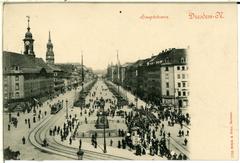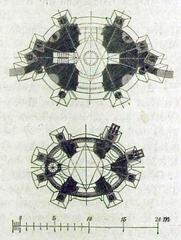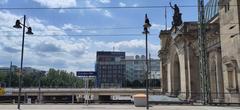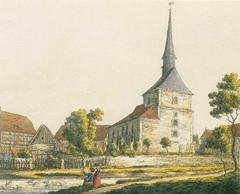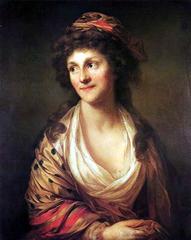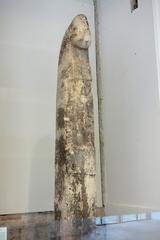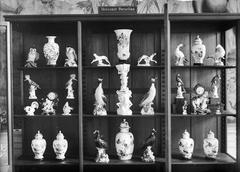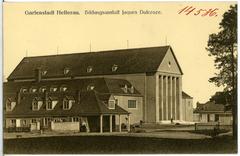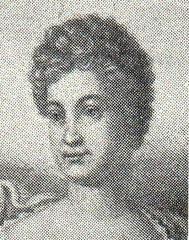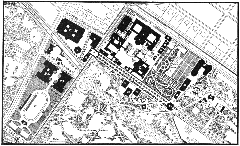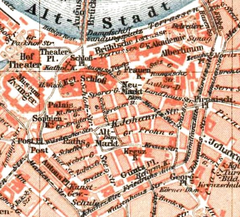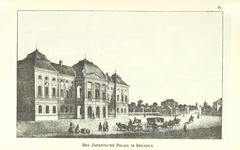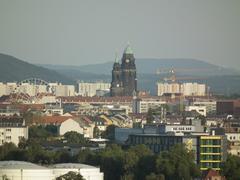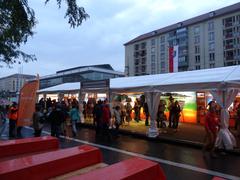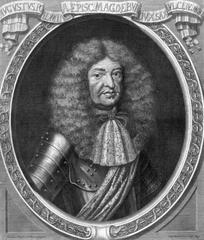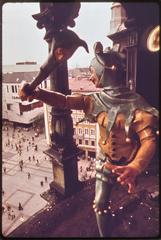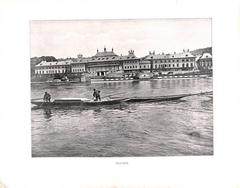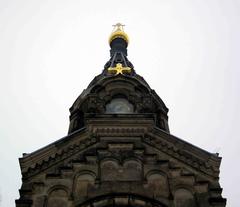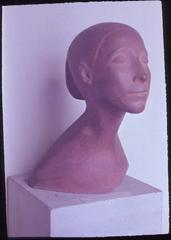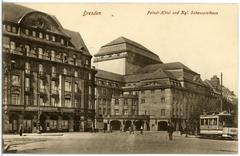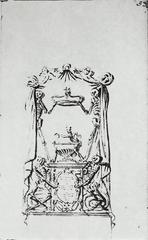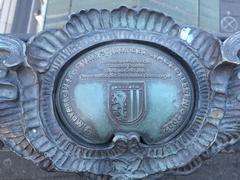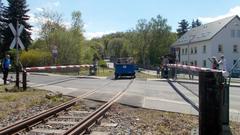Schloss Albrechtsberg Dresden: Visiting Hours, Tickets, and Historical Sites Guide
Date: 04/07/2025
Introduction
Schloss Albrechtsberg, perched elegantly on the northern banks of the Elbe River in Dresden, is a paragon of 19th-century aristocratic architecture and a vibrant center of cultural activity. Built between 1850 and 1854 for Prince Albrecht of Prussia, the palace’s neoclassical design, landscaped park, and panoramic city views have made it a beloved destination for history enthusiasts, architecture admirers, and cultural travelers. This guide offers detailed information on Schloss Albrechtsberg’s history, architectural highlights, visiting hours, ticketing, accessibility, and practical travel tips to ensure you make the most of your visit.
Official resources for up-to-date visitor information are the Schlösserland Sachsen website and the Dresden city tourism portal.
Table of Contents
- Introduction
- Historical Overview
- Visitor Information
- Architectural Highlights
- Cultural Significance
- Facilities and Practical Tips
- FAQs
- Contacts & References
- Conclusion
Historical Overview
Origins and Early Ownership
The site of Schloss Albrechtsberg was originally home to vineyards and a modest manor, reflecting the region’s long viticultural tradition (Dresden.de). In 1853, Prince Albrecht of Prussia acquired the property after political exile, initiating the construction of a new palace.
Architectural Vision and Construction (1850–1854)
Prince Albrecht commissioned Adolf Lohse, a student of Karl Friedrich Schinkel, to design a neoclassical residence inspired by Italian Renaissance villas. Construction began in 1850 and concluded in 1854, resulting in a three-story palace with grand staircases, reception halls, and ornate interiors. Eduard Neide, a disciple of Peter Joseph Lenné, designed the 11-hectare park, blending English and Italian landscaping with winding paths and rare botanical specimens (Schlösserland Sachsen).
Public Use and Transformation (1925–1990)
In 1925, Dresden acquired the palace, transforming it into a hotel and restaurant. During WWII, Schloss Albrechtsberg was spared major damage but briefly served as a Soviet military hospital and later as a children’s home. Under the GDR, it became a “Pionierpalast,” hosting youth education and cultural activities (Dresden.de).
Postwar and Restoration (1990–Present)
Following reunification, extensive restoration revivified the palace and its park. Today, Schloss Albrechtsberg is a protected monument and an active cultural venue, hosting concerts, exhibitions, weddings, and educational programs (Schlösserland Sachsen).
Visitor Information
Visiting Hours
- Park: Open daily from 8:00 AM to 8:00 PM (subject to seasonal changes).
- Palace: Accessible primarily via guided tours and during special events. Check the official website for tour times and event schedules.
Tickets and Admission
- Park Access: Free of charge.
- Interior Tours/Exhibitions: Tickets typically range from €5–€12, with discounts for students, seniors, and groups.
- Children under 12: Usually free for park and most events.
- Family Tickets: Available; see the official website for details.
Accessibility
- Park: Wheelchair and stroller accessible, with mostly even surfaces.
- Palace Interiors: Limited accessibility due to historic architecture. Contact ahead to arrange assistance.
Guided Tours and Events
- Tours: Regularly scheduled, offering insights into the palace’s history, architecture, and the life of Prince Albrecht. English tours available on request. Group bookings possible (Schloss Albrechtsberg).
- Events: Concerts, exhibitions, and seasonal festivals. Some events may affect access; consult the event calendar online.
Getting There and Nearby Attractions
- Tram: Line 11 to “Elbschlösser” stop; short walk through the park.
- Bike: Direct access via the Elberadweg cycle path.
- Car: Free parking available but limited during events.
- On Foot: Walking trails connect Schloss Albrechtsberg with Lingnerschloss and Schloss Eckberg, ideal for exploring the Elbe Castles ensemble (Wanderboat).
Architectural Highlights
Exterior and Park
- Neoclassical Façade: Defined by white sandstone, harmonious proportions, and a central portico with columns (kidpassage.com).
- Terraced Gardens: Designed in Italianate style, with panoramic Elbe views, formal lawns, fountains, and statuary.
- Römisches Bad (Roman Bath): Semicircular colonnade, central fountain, and pavilions—an archetype of 19th-century fascination with classical antiquity (neustadt-ticker.de).
Interior Features
- Grand Staircases and Reception Halls: Opulent décor, gilded moldings, parquet floors, and crystal chandeliers.
- Kronensaal (Crown Hall): Renowned for its scale, gold-framed mirrors, and chandelier (zu-gast-in-dresden.de).
- Turkish Bath: Moorish-Oriental design, famed as a film location (musik-dresden.de).
Restoration and Preservation
- Ongoing Projects: Restoration of the Römisches Bad and other features, with significant funding and public support (neustadt-ticker.de).
- Monument Status: Protected under Saxony heritage law; public access balanced with conservation (de.wikipedia.org).
Cultural Significance
Events and Educational Role
- Concerts and Festivals: Venue for classical music, “Meisterkonzerte,” balls, and civil weddings (dresden-elbland.de).
- Youth Programs: Continuing the tradition of arts education via the JugendKunstschule Dresden (schloss-albrechtsberg.de).
Integration in Dresden’s Culture
Schloss Albrechtsberg is integral to the Elbschlösser ensemble and a visible symbol of Dresden’s harmony between history, art, and landscape (wir-lieben-dresden.info).
Facilities and Practical Tips
Amenities and Services
- Restrooms: Available on grounds.
- Parking: Free, but limited during events.
- Pet Policy: Leashed pets permitted in park, not inside palace.
Dining and Accommodation
- Cafés & Restaurants: Nearby options include Historisches Fischhaus Dresden, Restaurant Lingnerterrassen, Sommerwirtschaft Saloppe, and Restaurant Schloss Eckberg (Wanderboat).
- Accommodation: Choices range from boutique guesthouses to hotels such as Hilton Dresden (Urtrips).
Family Activities
- Playgrounds: Waldspielplatz Albertpark offers a family-friendly experience.
- Seasonal Events: Family concerts, markets, and festivals held throughout the year.
Practical Tips
- Best Time to Visit: Spring and summer for gardens and events; early mornings or late afternoons for tranquility and photography.
- Photography: Allowed in park; check restrictions for interiors during tours.
- Language: German is primary; English tours and materials on request.
- Safety: Park is safe; remain on paths and respect historic features.
Frequently Asked Questions (FAQ)
Q: What are Schloss Albrechtsberg’s visiting hours?
A: Park is open daily from 8:00 AM–8:00 PM; palace interiors are accessible during guided tours and special events.
Q: How much do tickets cost?
A: Park access is free; interior tours cost €5–€12, with discounts available.
Q: Are guided tours available in English?
A: Yes, upon request. Book in advance.
Q: Is Schloss Albrechtsberg wheelchair accessible?
A: The park is accessible; palace interiors have limited access. Contact administration for details.
Q: Can I bring pets?
A: Leashed pets are allowed in the park, not inside the palace.
Q: What is the best season to visit?
A: Late spring through early autumn for gardens and events.
Contacts & References
- Address: Bautzner Str. 130, 01099 Dresden, Germany
- Phone: +49 351 8115821
- Official Website: Schloss Albrechtsberg
- Tourist Portal: Dresden City Tourism
References:
- Schlösserland Sachsen – Schloss Albrechtsberg
- Albrechtsberg Palace (Dresden) – Wikipedia
- Schloss Albrechtsberg Official Website
- Zu Gast in Dresden
- Neustadt Ticker
- Dresden City Tourism Portal
- Kid Passage
- Wanderboat
- Musik Dresden
- Dresden-Lese
- Dresden Elbland
- Urtrips
Conclusion
Schloss Albrechtsberg is more than a historical monument; it is a living symbol of Dresden’s elegance, resilience, and cultural vitality. Its harmonious architecture, lush gardens, and dynamic programming invite all visitors to experience the intersection of history, art, and nature. For a seamless trip, consult official resources, download the Audiala app for guided tours and tips, and immerse yourself in the grandeur of one of Dresden’s most captivating sites.


